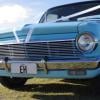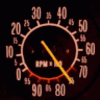Well I got all enthusiastic and tested a couple of carbs this arvo. I wasn't really sure what test pressure to use seeing as there are so many different "standards" but settled on the most commonly used one for carburetors of 1.5"Hg. I calibrated the bench with a 1.5" orifice before testing so the figures are good. The carb adaptors basically just dumped straight into a 3.625" bore so the flow numbers are about what you'd get dumping into a plenum manifold. A runner with a smoother transition would give a few percent more flow but at any rate they were all tested the same way so the numbers are comparable.
A Mikuni VM40 was the first one tested, it did 218cfm and ran quietly. These are a traditional round slide design and I think one of the best all-round performers ever.
Next was a flat-slide Mikuni VMX38, it's claimed that they flow a little better than the VM for a given size and that indeed turned out to be the case. It did almost as well as the VM40 despite being 2mm smaller, with 211cfm. It was very very quiet. The flow path for these is basically the same as the HSR series, so you could use this as a guide for selecting HSRs.
I also tested a 32mm round-slide which did 125cfm.
Next I chucked on a 1-3/4" SU, and was careful to mount it at about the same angle as it would be in a car so as not to affect the slide operation. This did 188cfm but keep in mind that all the other carbs had bellmouthed entries while the SU had neither a bellmouth or an air cleaner base. I couldn't put a radiussed entry on it (my tin of playdoh had gone hard!) but I'd expect that a bit better entry would get it just over 200cfm. I might grab some fresh playdoh tomorrow and check it to be sure. I don't have any 2" SUs here to test but going by the figures for the 1-3/4" I'd expect around 250cfm.
What did surprise me was just how little it took to open the slide on the SU - I was expecting it to be more restrictive. The slide was 90% open with 7"H2O pressure drop and at 10.7" it was fully open. Keep in mind that the last little bit of slide lift adds very little area to the throat, so for all practical purposes it could be considered fully open with about 7 - 7.5" of suction. Drag racers using Holley style carbs have found best results when the carbs are sized to give between 0.5" and 0.75"Hg across the line, and this works out to about 7 to 10" of water, exactly where the SU runs at WOT. I've heard reports of SU slides not fully opening - or even closing a little - at very high rpms. I saw no sign of this behaviour even with 28" or more suction and have to wonder if these misbehaving carbs have been subjected to some of the half-arsed mods that are commonly carried out.
The other interesting thing about the SU was the action of the oil damper. Whenever the throttle was opened or the airflow increased the slide would initially lift fairly quickly but then get progressively slower and slower as the slide position reached a point of balance with the airflow. The last couple of mm was painfully slow and could take 5 seconds or so to complete even with a completely stable airflow. I can see now why some people sacrifice some initial enrichment by leaving out the damper. Perhaps some work on piston or damper rod design could give the best of both worlds? At any rate the old SU certainly did better than I expected. In circuit racing applications the Webers seem to have the upper hand over SU's but I can't help but wonder if this advantage would go away with adequately sized and set up SU's on a good manifold?
Finally I chucked on a 350 Holley, mainly just as a sanity check. This had the choke tower still intact but no choke flap or spindle. It did 178cfm (one throat only) which is about what you'd expect. It was noisier than the others and for comparisons sake has 38mm throttle bores and 30.5mm "chokes". It seems the Holley cfm ratings are accurate so you should be able to use them with confidence, just be aware that some of the "special" Holleys as well as many of the lookalikes rate their carbs at oddball pressure ratings. The DCOES look a little dirtier aerodynamically - I don't have any here to test - but I think the figures for identically dimensioned Holleys would be close enough to get in the ballpark.
Back to the Mikunis for a minute - these things flow amazingly well. So well in fact that fitting one to an appropriately sized manifold runner doesn't decrease the flow in the slightest. It actually
increases flow. As far as the manifold is concerned the carb is nothing more than another couple of inches of runner length with a bellmouth. Looking at the flow rates now it would appear that the smallest of the HSRs, the 42mm, would be adequate for even a very quick race motor. They'd also be oversized for nearly any street/strip car, where a 36 or 38 TM or PWK might be more appropriate.
Edited by oldjohnno, 27 February 2016 - 08:03 PM.




 View Garage
View Garage












